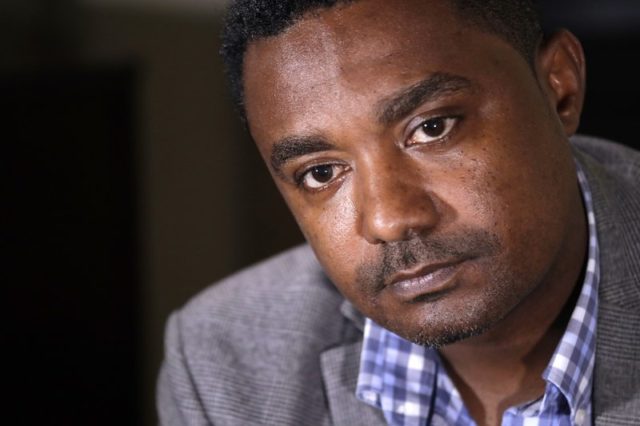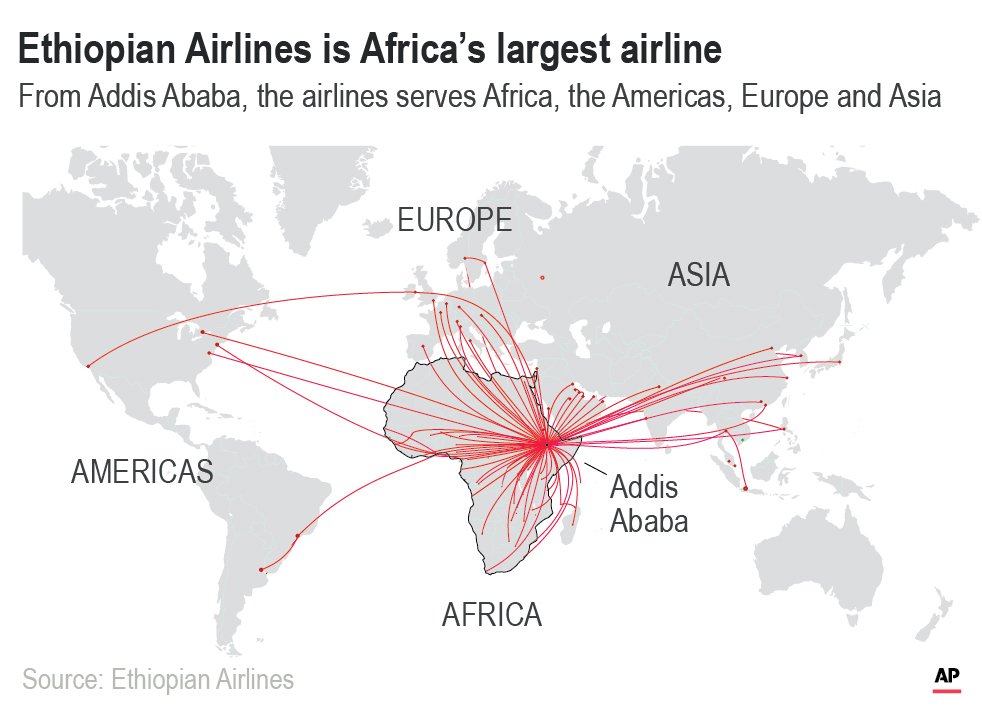SEATTLE – AP || Ethiopian Airlines’ former chief engineer says in a whistleblower complaint filed with regulators that the carrier went into the maintenance records on a Boeing 737 Max jet a day after it crashed this year, a breach he contends was part of a pattern of corruption that included fabricating documents, signing off on shoddy repairs and even beating those who got out of line.
Yonas Yeshanew, who resigned this summer and is seeking asylum in the U.S., said that while it is unclear what, if anything, in the records was altered, the decision to go into them at all when they should have been sealed reflects a government-owned airline with few boundaries and plenty to hide.
“The brutal fact shall be exposed … Ethiopian Airlines is pursuing the vision of expansion, growth and profitability by compromising safety,” Yeshanew said in his report, which he gave to The Associated Press after sending it last month to the U.S. Federal Aviation Administration and other international air safety agencies.
Yeshanew’s criticism of Ethiopian’s maintenance practices, backed by three other former employees who spoke to AP, makes him the latest voice urging investigators to take a closer look at potential human factors in the Max saga and not just focus on Boeing’s faulty anti-stall system, which has been blamed in two crashes in four months.
It’s not a coincidence, he said, that Ethiopian saw one of its Max planes go down when many other airlines that fly the plane suffered no such tragedy.
Ethiopian Airlines portrayed Yeshanew as a disgruntled former employee and categorically denied his allegations, which paint a blistering counterpoint to the perception of the airline as one of Africa’s most successful companies and a source of national pride.
Yeshanew alleged in his report and interviews with AP that Ethiopian is growing too fast and struggling to keep planes in the air now that it is carrying 11 million passengers a year, four times what it was handling a decade ago, including flights to Los Angeles, Chicago, Washington and Newark, New Jersey. He said mechanics are overworked and pressed to take shortcuts to get planes cleared for takeoff, while pilots are flying on too little rest and not enough training.
And he produced an FAA audit from three years ago that found, among dozens of other problems, that nearly all of the 82 mechanics, inspectors and supervisors whose files were reviewed lacked the minimum requirements for doing their jobs.
Yeshanew included emails showing he urged top executives for years to end a practice at the airline of signing off on maintenance and repair jobs that he asserts were done incompletely, incorrectly or not at all. He said he stepped up his efforts following the Oct. 29, 2018, crash of a Lion Air Boeing 737 Max in Indonesia that killed all 189 people on board. One email Yeshanew sent to CEO Tewolde Gebremariam urged him to “personally intervene” to stop mechanics from falsifying records.
Those pleas were ignored, he said. And after the March 10, 2019, nosedive crash of an Ethiopian Boeing 737 Max outside Addis Ababa that killed all 157 people on board, Yeshanew said it was clear the mindset had not changed.
Yeshanew said in an interview that on the day after the crash, Ethiopian’s Chief Operating Officer Mesfin Tasew openly agonized that the airline could get blamed because of its maintenance “issues” and “violations,” and he ordered that records on the downed Max plane be checked for “mistakes.”
“We pray to God that this will not point to our fault,” Yeshanew quoted the COO as saying.
That same day, Yeshanew said in his report, someone logged into the computerized maintenance record-keeping system, specifically on the records from the downed plane that detailed a flight-control problem — “a roll to the right” — that pilots had reported three months earlier. Yeshanew included in his report a screenshot of a directory of the records related to the problem that showed a final entry that was time-stamped March 11.
Yeshanew said he didn’t know what was in the records previously or if they were changed, only that the records were left to say that tests had been done and the issue had been resolved. While he doubted that the flight-control problem brought the plane down, he said any changes to the records would call into question the actual condition of the airplane at the time of the crash as well as the integrity of the airline as a whole.
Aviation experts say that after a crash, maintenance records — specifically, log books and task cards containing notes by pilots and fixes by mechanics — are required by international air safety regulators to be immediately sealed off, and any attempt to manipulate them is a serious violation tantamount to trampling on a crime scene.
“If there is an accusation that you went into records, it means you’re hiding something, you have something to hide,” said John Goglia, a former member of the U.S. National Transportation Safety Board and an expert in aircraft maintenance.
In its response to AP, Ethiopian denied a history of tampering and shoddy maintenance, and denied its COO or anyone else ordered someone to change the maintenance records on the downed 737 Max. It said that as soon as the accident happened, those documents were sealed, stored in a secure place and delivered to Ethiopia’s Aircraft Accident Investigation Bureau. It added that while “a technician tried to see the aircraft records,” its review found no data was changed or updated.
Ethiopian is Africa’s biggest airline, is profitable and is one of only a few on the continent that have passed the tests necessary to allow their planes to fly into Europe and North America, with a relatively good safety record.
The company confirmed Yeshanew served as director of aircraft engineering and planning but said he was demoted because of a “serious weaknesses in leadership, discipline and poor integrity.”
“He is a disgruntled ex-employee who fabricated a false story about Ethiopian Airlines, partly to revenge for his demotion while working in Ethiopian, and partly to probably develop a case to secure asylum in the USA,” the airline said in an email to AP. “We would like to confirm once more that all his allegations are false and baseless.”
Yeshanew and his attorney, Darryl Levitt, said that he was never demoted and, in fact, his steady rise through the ranks over a 12-year career at Ethiopian continued even into this year when he was tapped to oversee a new venture making aircraft parts and investigate two pilots who botched a landing in Uganda and nearly skidded into Lake Victoria. Yeshanew said his recommendations after that incident — fewer inexperienced pilots in cockpits and better training — went unheeded.
Yeshanew also attached internal emails to the report that he contends show faulty paperwork and repairs, and investigations from parts suppliers that point to similar errors, including ones that led to two cockpit windows shattering in flight, a de-icing mechanism burning, and missing or incorrect bolts on key sensors.
“I personally saw that many task cards are signed without even doing what is written in the instruction,” Yeshanew wrote to COO Tasew in 2017. “Such violations may even result in a serious safety issue.”
Others have made similar claims. In 2015, an anonymous employee told an FAA safety hotline that mechanics often cleared planes for takeoff with “unresolved” mechanical issues. It was unclear if the complaint led to any action by the FAA or the airline.
Three other former Ethiopian employees made such allegations to AP, including one who provided documents that he said show faulty repairs and paperwork errors stretching back years, and another who said mechanics felt they had no choice but to “pencil whip it” — industry jargon for signing off on repairs never done.
“They would actually lie about it,” said Franz Rasmussen, who flew for the airline for two years before leaving in 2016. “There was a philosophy: You can’t ground an airplane — it’s go, go, go.”
Among the allegations in Yeshanew’s report is that Ethiopian maintains a jail-like detention center on the grounds of its Addis Ababa headquarters that it used to interrogate, intimidate and sometimes beat up employees who got out of line. Yeshanew said he knows of at least two mechanics beaten up in the past three years after falling out of favor with the company, and he feared the same fate awaited him.
Yeshanew said in the report and later interviews with AP that he was taken to the single-story, dirt-floored detention center in July on suspicion he was talking to news organizations, and after 10 hours of questioning was told he would be thrown into jail “like all the other persons before” him if he didn’t keep quiet. He took that as a threat of torture.
“If you are in jail, it means you’ll be beaten, you will be tortured,” he told AP. “There is no difference in the current political system of Ethiopia.”
Four days later, Yeshanew fled to the U.S. with this wife and two children and settled in the Seattle area.
A former spokesman for the airline union, Bekele Dumecha, told AP that he met with more than a dozen workers over six years who had been beaten at the same detention center, including one of the alleged victims identified by Yeshanew. Dumecha said he saw that person an hour after he was released, bruised and staggering.
“He couldn’t walk properly,” said Dumecha, who is now living in Minnesota and also seeking asylum. “He was mentally and physically destroyed.”
Human Rights Watch said in an April report that torture in jails and “unmarked detention centers” have long been a “serious and underreported problem” in Ethiopia, and its former researcher there said he personally interviewed three airline workers who alleged they were tortured by the government, the most recent three years ago.
“It was all about ensuring the positive image of the company and the country is kept intact,” said HRW researcher Felix Horne. “Many people who tried to speak out against government-controlled companies were inevitably thrown in prison and beaten up.”
In its statement, Ethiopian Airlines denied that a detention center for torture exists and offered to show an AP reporter around the grounds. But after AP sought such a tour this past week, Ethiopian officials said it would take several weeks to arrange.
Yeshanew’s allegations are the latest to cast a light on factors other than what has become the overriding focus of the Max crash investigations — a system on the plane called MCAS, for Maneuvering Characteristics Augmentation System, that automatically pushes the plane’s nose down when it is at risk of stalling.
Preliminary reports indicate it misfired in both fatal crashes, with pilots losing control of the planes as they fought against it. Regulators have grounded nearly 400 737 Max planes while Boeing tries to fix the problem.
Another whistleblower from Ethiopian, veteran pilot Bernd Kai von Hoesslin, told the AP in May that after Indonesia’s Lion Air crash, he pleaded with Ethiopian’s top executives to give pilots better training on the Max, predicting that if pilots are not sufficiently drilled on Boeing’s protocols for how to disable the autopilot system in the event of a misfire, “it will be a crash for sure.”
Ethiopian has said the pilots followed all the steps Boeing laid out. But the preliminary report on the crash showed they deviated from the directives and made other mistakes, notably flying the plane at an unusually high speed and inexplicably reactivating the anti-stall system shortly after manually overriding it. Six minutes into the Max flight, the plane with passengers from nearly a dozen countries cratered into the ground about 40 miles from the airport.
For the 39-year-old Yeshanew, the decision to become a whistleblower has come at a heavy price. He is leaving behind relatives and a job that he called “the dream of my life,” one with prestige and a big enough salary for him to buy a three-story house. He is not sure of what kind of job he can get in the U.S., or if he will even be granted asylum.
Ultimately, he said, he has dreams of returning to his native Ethiopia and even going back to work at Ethiopian Airlines.
“I have to reveal the truth, the reality to the world, so that the airline will be fixed,” he said, “because it can’t continue like what it is doing now.”
































Oh no!!! Oh no!!! Now that loose lips about we Ethiopians, so-called aviation consultant for ABC News will have a field day upon hearing this. Oh no!!! Why dear old countryman? Why? My goodness gracious!!! Why? I am sickened by this story!!!! Oh no!!!